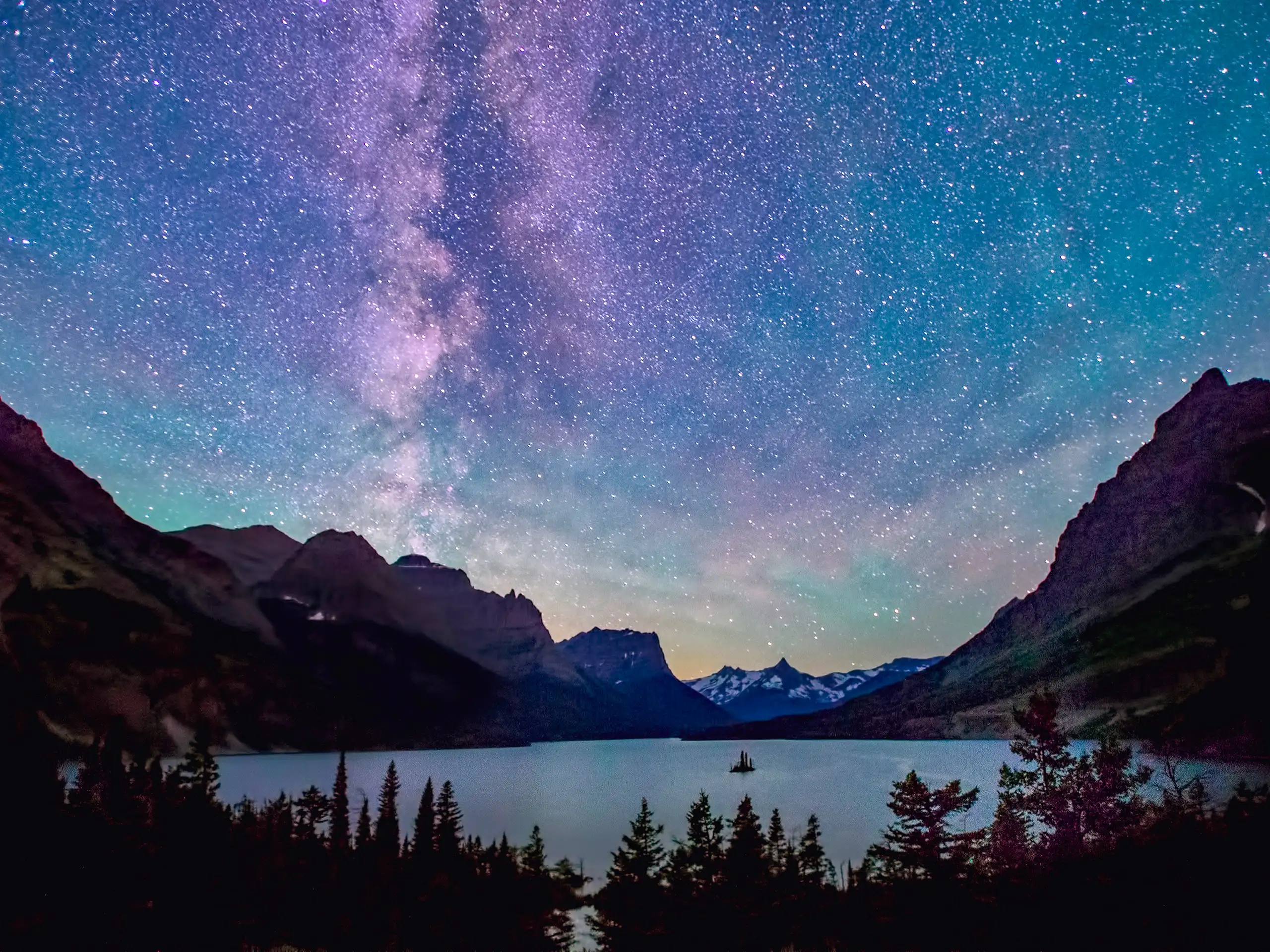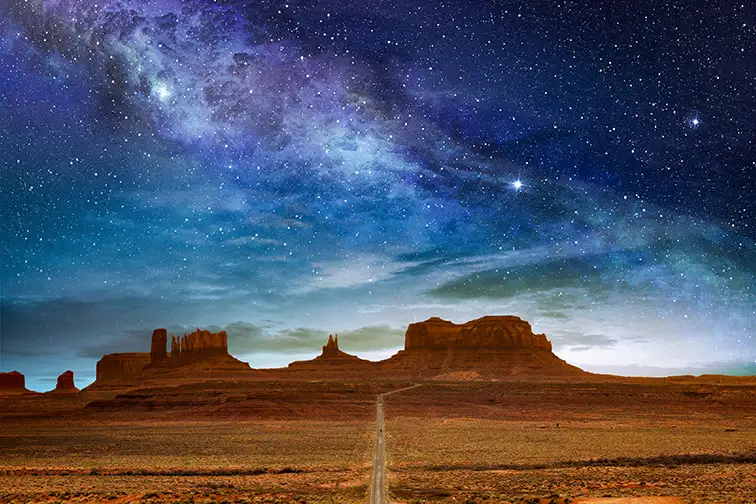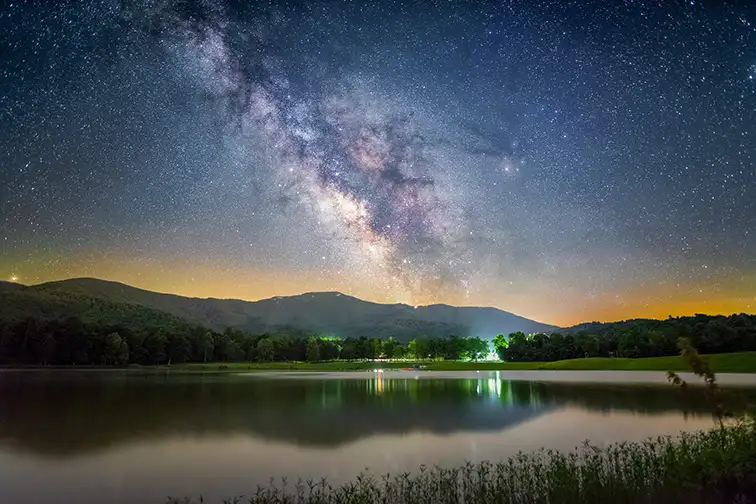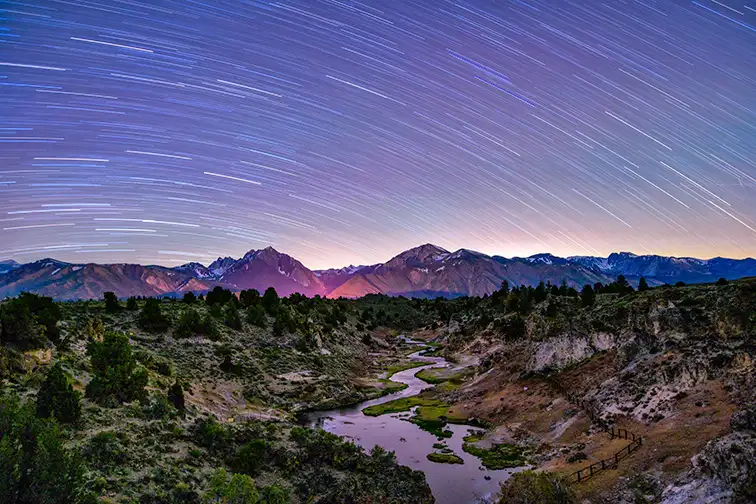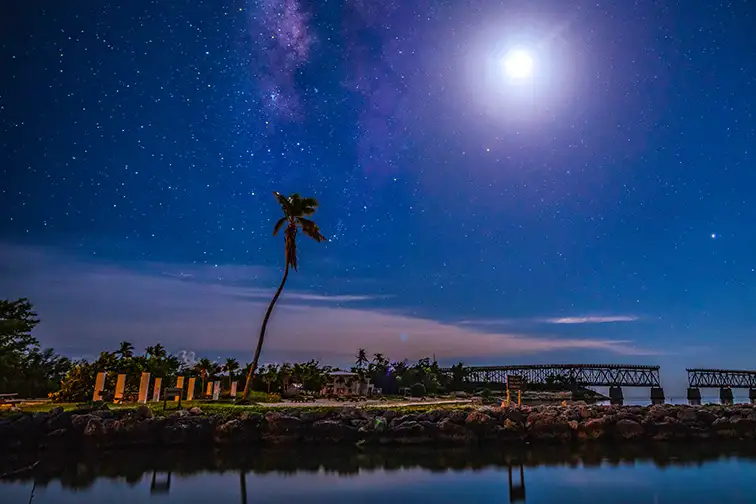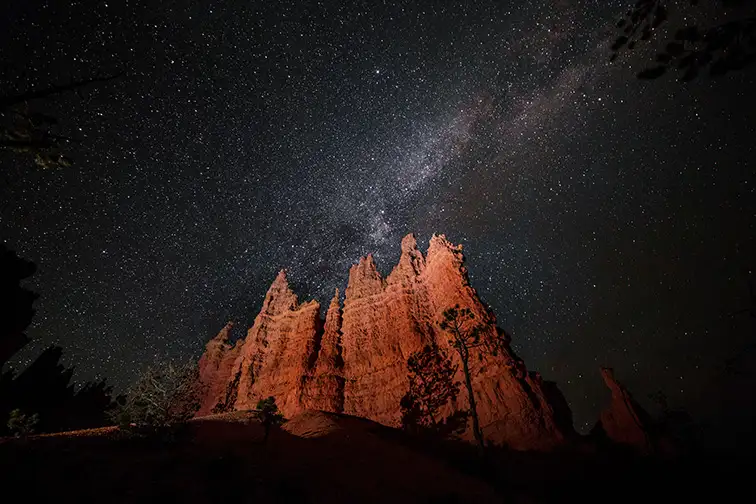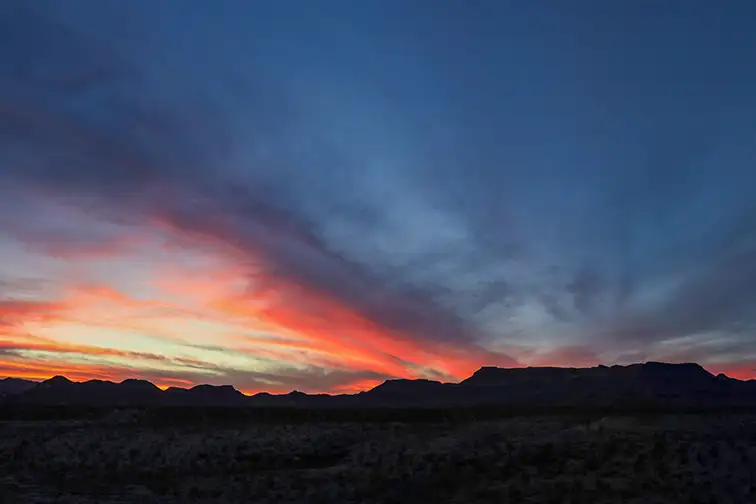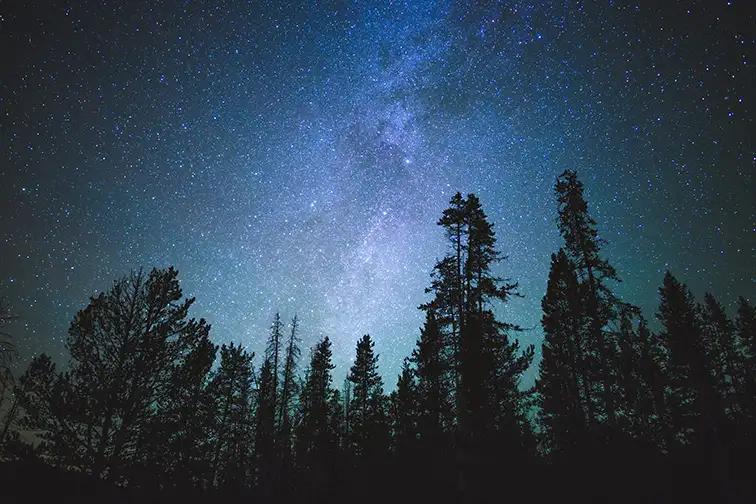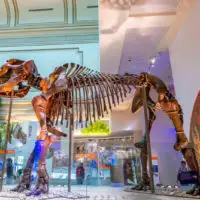Come nighttime on vacation, many parents get excited for kid-free evenings and uninterrupted time with a glass of wine, perhaps in front of the TV or on their smartphone. Instead, opt for a mindful moment with the kids outside, under the stars. From stargazing and starbathing to evenings in certified International Dark Sky Parks, there’s a constellation, comet or glance at cosmic bliss that will tempt everyone from your tiniest to your teen (and you, too). Forge on past the eight planets and into the resorts, parks, rivers, lakes and forests in these eight states that lead the nation in astrotourism. These are the best places for stargazing in the U.S.
Editor’s Note: Due to COVID-19, some destinations may have reduced or cancelled stargazing activities. Be sure to check with the property/park directly before visiting.
Asteroid Arizona
Asteroid: A solid body orbiting the sun that consists of metal and rock. Most are only a few miles in diameter and are found between the orbits of Mars and Jupiter, too small and far away to be seen easily in a small telescope. A few venture closer to the sun and cross Earth’s orbit.
Flagstaff: Flagstaff is located on the western edge of the world’s largest ponderosa pine forest and holds the title of World’s First International Dark Sky City. The city has much to offer in terms of astrotourism, including the Northern Arizona University, Lowell Observatory, and The U.S. Naval Observatory. Plus, close proximity to the Grand Canyon, Oak Creek Canyon, Arizona Sunbowl, Meteor Crater, and famous Route 66 provide ample opportunities to observe incredible nighttime wonders.
L’Auberge de Sedona, A Destination Hotel: This Sedona hotel offers something called Star Bathing, an adaptation of the property’s renowned Shinrin-Yoku or “Forest Bathing,” which is even more enticing for the family. A certified Forest Bathing facilitator guides resort guests toward heightening their senses. Vision is reduced by the darkness of night and awakens the senses. (This is probably best for your teenager or those who can truly stay up late.) Bonus: this experience is complimentary for hotel guests and is part of the weekly guest activities. Non-guests are able to book private sessions.
Mountain Shadows Resort: This Paradise Valley resort has a Sun, Moon & Stars Wellness Series with offerings such as Moonlight Yoga and ‘Sipnic Under the Stars,’ where adults can customize wine-forward picnic baskets and enjoy them on the lawn with the kids while taking in breathtaking Camelback Mountain. Celestial celebrations can continue with a Cocktails Under the Cosmos series, complete with an astrology-themed cocktail reception on the rooftop deck under twinkling lights. The beautiful night sky, seen brighter in Paradise Valley with its low light pollution and dramatic desert backdrop, is the ultimate way to cherish cosmic skies with the family in Arizona.
The Boulders Resort & Spa: Situated on 1,300 acres in the Sonoran desert, this hotel is perfect for stargazing due to a slightly higher elevation from the valley below. The Boulders’ environmentally friendly practices prohibit light pollution and keep external lighting at a minimum to allow guests to view the full brilliance of the stars lighting up the desert night sky. There is no night lighting at the tennis courts, the swimming pools or other areas throughout the resort; instead, the resort provides guests with special flashlights to guide them through the pathways at night. Some of the night programs include:
- Stargazing with the resort’s professional astronomer who helps guests view planets, stars, constellations and the lunar surface–from canyons to craters–through a high-powered telescope.
- Moonlight bicycling is a great outdoor adventure for teens. Suddenly, the desert sky becomes a planetarium; night-blooming cacti explode in a kaleidoscope of various colors. The Boulders supplies bikes, helmets, water and night equipment (a 15-watt lighting system) that boosts confidence in navigating in the darkest of night.
- There’s also summer night golf for teens and with “glow” golf balls.
Variable Virginia
Variable: A variable star is a star whose brightness changes over the course of days, weeks, months, or years.
Shenandoah National Park: Shenandoah is a superb and affordable option for a magical night sky experience. Greg Redfern, a NASA-affiliated astronomy professor, has a weekly presentation, “Let’s Talk About Space at Shenandoah,” with intricate details about the sky above and the local area. This is offered in season at Big Meadows Lodge. The national park also hosts an annual Night Sky Festival in August.
Primland: Situated on 12,000 acres in the southwest Virginia mountains near the Blue Ridge Parkway is Primland resort, an exceptional option for some of the East Coast’s best stargazing thanks to the high altitude and remote location of the property. There is an onsite Observatory Dome with a resident astronomer who leads nightly ‘Tour of the Universe’ programs using the resort’s Celestron 14-inch telescope. The tour starts with an outside demonstration of constellations and planets (weather dependent), then moves to mind-blowing topics like star formation and star death, galaxy formation, and the grand scale of the universe.
Canaan Valley Resort: Technically in West Virginia, there’s a state park and mountain destination in the Potomac Highlands—Canaan Valley Resort—that sets the scene for variable stars with 160 rooms, 23 cabins, and 34 campsites. There is also a championship golf course that showcases incredible skies, outdoor pool and indoor pools to keep everyone busy, and 47 slopes and trails for winter snow fun or awesome hiking and viewing of galaxies. The resort is situated in a valley surrounded by mountains; virtually everywhere you look, you’ll be able to see the stars. On full-moon nights, the light of the moon will guide you. The resort has 18 miles of marked trails, many linked to the Monongahela National Forest, meandering through woodlands, meadows, and along streams.
Cosmic California
Cosmic: relating to the universe or cosmos, especially as distinct from the Earth. It also means inconceivably vast, much like the evening stargazing opportunities in California.
Mammoth Lakes: Mammoth Lakes is a village within the trees, providing ample opportunities to gaze at the stars due to very little light pollution, which is actually enacted by a town ordinance. The night sky is so clear, you don’t even need a telescope to view the constellations! For a true cosmic evening in summer, book a stay at the Tamarack Lodge, which is completely disconnected from the lights of town. Additional astro-friendly spots include Minaret Vista, the Mammoth Crest, and Mono Lake, a short drive north of Mammoth. All of these spots add a fun nighttime hiking/walking element to your adventure.
The Landing Lake Tahoe Resort & Spa: South Lake Tahoe can set the stage for an impressive evening sky, combining water, cool mountain air, and clear skies. The Landing Lake Tahoe Resort & Spa, located on the South Shore across the street from the lake, offers families abundant space to take in the stars. There is an outdoor pool with a chaise lounge to snuggle and soak in the solar system. Or, choose to enjoy unobstructed views on the rooftop patio. If you’re seeking a more private experience, each guestroom offers a deck with great views of the night sky to take in the evening magic.
Little River Inn: One of the most dazzling aspects of the northern region of California is that as you go farther north, the stars get brighter and the skies get clearer. Nowhere is this phenomenon more visible than on the Mendocino Coast. The historic Little River Inn has a package for four that includes two nights of lodging in a traditional oceanview room with two queen beds, a Little River Inn travel blanket, and an opportunity to borrow the hotel’s stargazing kit with special binoculars, a star map, star guide, and flashlight. Hot chocolate is included, too!
The Ritz-Carlton, Rancho Mirage: This luxury hotel capitalizes on its proximity to open space and incredible night skies. When weather permits, guests are treated to complimentary stargazing led by a recreation ambassador and a powerful 11-inch computerized Celestron telescope that magnifies even the most distant astronomical wonders. Stargazing is complimentary for guests on Friday, Saturday and Sunday evenings from 7 to 8:30 p.m. To complement the stunning visuals, adult guests can head to State Fare Bar & Kitchen where the expert mixologists can shake up constellation-themed cocktails, including the Mirage Milky Way.
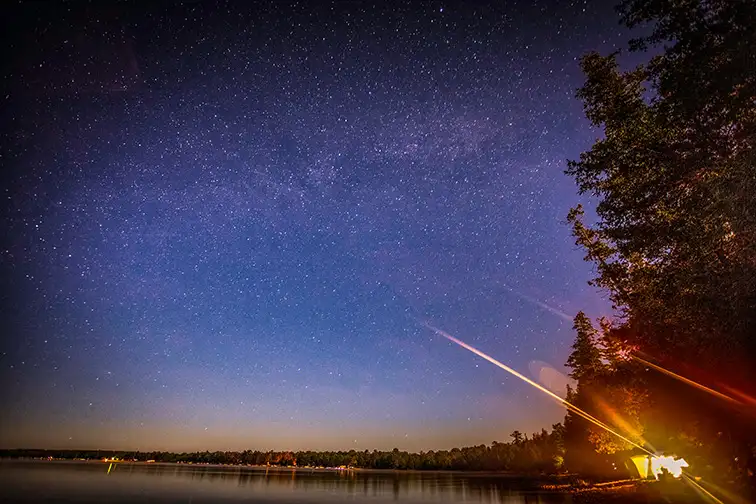
Milky Way Michigan
Milky Way: The Milky Way is a name that describes the galaxy’s appearance from Earth.
Headlands International Dark Sky Park: This park is open 24 hours a day, but clearly, the objective of this trip is for the nighttime magic. Remember to use red-filtered flashlights come evening, to protect the sanctity of the park. (There is an observatory, but it’s limited to park staff and researchers). However, visuals, when the observatory is open, are projected onto the big screen monitors on the main level for visitors to see. Professional stargazers and astronomers are located onsite to enhance your viewing experience during scheduled observing nights. Most families yearn to see the Northern Lights that occur from solar wind and these can be visible from the park.
Mackinac Island: Located where Lake Huron and Lake Michigan meet, Mackinac Island is a special spot in the Midwest. The island has a ban on motor vehicles; therefore, transportation comes in the form of horse-drawn buggies and bikes. A remote island is a place where families can unplug and reconnect in a fun environment and take advantage of the amazing night sky. There are numerous hiking and biking trails circling the island to take in an evening stroll. Mission Point, located on 18 acres of the island, has a 239-room property with its expansive Great Lawn, perfect for viewing the Michigan Milky Way. Plus, there is a complimentary kids’ club for children ages 5 to 12.
Florescent Florida
Florescent: amazingly bright or vivid. From the melting horizons to magical lights from under the ocean, Florida has some of the best sky to sea skies in the nation.
Bahamas Paradise Cruise Line: This cruise line actually serves up a double dose of astronomy. Families embark on a two-night cruise to Grand Bahama Island where they not only take in florescent Florida, but they can also get a big bang from the Bahamian night sky. There are multiple spots throughout the ship to take in the night sky, including a chaise lounge poolside, an aerial view from the top deck, or in multiple bars and open-air restaurants throughout the vessel. There are two Bahamas Paradise Cruise Line ships and both leave from the Port of Palm Beach and dock in Freeport, Bahamas (Grand Bahama Island) for the day. Within hours of leaving port, the twinkling lights of coastal Florida cities begin to light up as the sky begins its nightly show. There are some extremely special evenings when rocket launches from Port Canaveral are within view from the ship, and that is when the sky truly goes florescent!
Big Cypress Swamp Welcome Center: The Big Cypress Swamp Welcome Center in Ochopee, invites families for an evening of dark sky education and celebration. National parks, including Big Cypress National Preserve, are home to some of the last remaining dark skies in the country and are committed to protecting the night sky resource. Travelers can view one of the darkest skies in the eastern United States by attending a ranger-led astronomy program. This 45-minute interpretive program begins at 7 p.m. on the first Saturday of the month (check the official website to confirm), followed by telescope viewing. This event is free and open to the public and there are no reservations necessary.
The Ritz-Carlton, Amelia Island: Take in the night sky at The Ritz-Carlton, Amelia Island. The resort is poised on a bluff of dunes overlooking the Atlantic Ocean and offers a tranquil seaside backdrop that’s perfect for a quiet night to explore the sky. The hotel provides prime access to pristine beaches and has a special bonus that can be arranged in advance: an onsite astronomer that can take families on an evening tour—showing off the best constellations, stars, and, sometimes, planets with his high-tech telescope. Pair your experience with a beach bonfire and gourmet S’mores in the dunes.
Ultimate Utah
Ultimate: the best achievable or imaginable of its kind. Utah has one of the largest selections of nighttime experiences due to large, open spaces and few people.
Bryce Canyon National Park: Utah has 11 certified International Dark Sky Parks, with more currently in the certification process. Visit Head Dark Ranger and local legend, Kevin Poe, at Bryce Canyon National Park for a memorable experience. Poe has nearly two decades of astronomy experience and can lead families on an intimate telescope tour with larger-than-life views, expert facts and rare sightings. Fun Fact: One of Utah’s best-kept secrets is the expansive sky fields of stars during the winter months. Not only does the night sky arrive earlier in the day, but winter skies also tend to have less moisture, making them more transparent to the human eye.
OARS: “Stars with Lars” on the Cataract Canyon Astronomy Trip with OARS allows families to float their way into the nighttime show. The Cataract Canyon astronomy trips in Canyonlands National Park run by Guide Lars Outside’s 2015 River Guide of the Year, showcases his knowledge of the galaxy and local area. Lars has a high-powered telescope and laser pointer and offers nightly star talks where he shares his vast knowledge of the celestial universe as guests get a chance to gaze up and see the stars like never before. The trip starts with 52 miles down the Colorado River and ends at Lake Powell, the most beautiful spot to see the bright stars. Stargazing on the river in a national park is something truly magical and special.
The San Juan River Rafting Astronomy Trip, also with Lars, is a combined cosmic education and storytelling session with his expansive knowledge of the culture and history of the desert southwest. Start the trip down the San Juan River at Sand Island and finish off with hiking through Utah. The incredible hiking consists of seeing River House, Morman Trail, Mule Ear diatreme, and so many other incredible hiking climbs and views. This combination even has its own name—archeoastronomy!
Under Canvas Zion: Fall asleep under the stars and to the sounds of nature at Under Canvas Zion in Zion National Park. Under Canvas provides luxury “glampsites” that help families create an immersive escape, situated in remote locations amongst America’s most iconic national parks and monuments. With spectacular views of the Milky Way and fresh desert air, families can wake up fully rested and connected to the land. The safari-style Stargazer tent has a night sky-viewing window, strategically placed above a king-size Casper bed with luxury linens for cozy, undisturbed stargazing.
Red Mountain Resort: Red Mountain Resort is ideally located to take in the nighttime skies of Utah. Located in the southern portion of the state, the resort is in St. George with close access to Bryce Canyon and Zion National Parks, and Snow Canyon State Park is less than a half-mile away. There are regular stargazing excursions where guests can use telescopes to see moons, nebulas, and planets and learn general astronomy. Carolyn Ford, PhD, also offers a variety of astrological readings to help guests dive deeper into the meaning of the stars, including Intuitive Astrology sessions and oracle readings.
Twilight Texas
Twilight: the soft glowing light from the sky when the sun is below the horizon, caused by the refraction and scattering of the sun’s rays from the atmosphere.
Big Bend National Park: Big Bend National Park is located in far west Texas, close to the Mexico border, where the crowds are minimal and the night skies are epic! The park and landscape is claim to the darkest sky in the lower 48 states and is one of only 13 parks in the entire world to have the designation of gold-tier from the International Dark Sky Association. There are programs and nighttime walks throughout the year to help educate and explore this anomaly. The Milky Way is in full view and rangers claim that you can see approximately 2,000 stars on a clear night.
La Cantera Resort and Spa: La Cantera Resort and Spa in San Antonio has one of the best spots to view twilight—their pools. The resort, located in Hill Country, is home to five pools, including an adults-only infinity pool lined with 10 chic cabañas and a poolside bar. Whichever pool you choose, the chaise lounge will be an ideal spot to set your sights toward the sky. The resort has a naturalist program for kids, as well as a kids’ camp, tennis, arcade and much more to keep children busy during the day so they can relax and enjoy the incredible evenings in Texas Hill Country.
Interplanetary Idaho
Interplanetary: located or moving between planets. Idaho has the most access to waterways and cosmic waves than any other place in the nation.
Northwest Rafting Company: The Northwest Rafting Company offers six-day whitewater rafting trips on the Middle Fork of the Salmon River through the Frank Church River of No Return Wildnerness Area. The river is just outside the boundaries of the first “Dark Sky” gold-tier stargazing reserve for good reason due to these initiatives. The “River of No Return” features 100 miles of rafting from its start near Stanley to its completion at the confluence of the main Salmon River. The only ways to reach this original Wild and Scenic River are by riding a horse, hiking, flying to small private airstrips or rafting. The best option for families? Paddle by day and camp at riverside campgrounds by night under clear skies with no light pollution.
Shore Lodge: If you want to keep the family in one spot, but still crave the cosmic shores, Shore Lodge has posh accommodations and perfect galaxy gazing experiences for the family. Guests of Shore Lodge, McCall’s premier lakefront resort, can expect to see the Milk Way with the naked eye and framed by pine trees and silhouettes of the stately Salmon River Mountains. The resort’s in-room balconies and private dock offer great perches to take in the West’s big night sky, and the latter has a nearby bonfire with S’mores as a stargazing snack. For an unforgettably majestic view, Shore Lodge can arrange for guests to be transported to a moonlit yurt nestled high in the mountains, where they can get up close with brightly illuminated constellations and shooting stars.
Limelight Hotel: Ketchum has been officially designated as the first International Dark Sky Community in Idaho, joining only 10 other International Dark Sky Communities in the United States. In honor of this designation and in the hopes of continuing education regarding astronomy, the Limelight Hotel offers complimentary Star Gazing Planetarium Nights that entail a mobile planetarium of constellations and a 45-minute presentation by local astronomy enthusiast, Scott Slonim. The activity is offered once a month.
Julie Bielenberg is a Denver-based journalist and Colorado’s leading agritourism writer. She contributes her expertise to various outlets including AAA, USA Today 10 Best, 5280, Westword, Mountain Town Magazine, Hunting Life, and Mile High Mamas. Julie also works with the National Dude Ranchers Association. When she’s not traveling or on horseback, Julie is at home with her husband and three young children, who are passionate about everything Colorado has to offer, from skiing to hot springs! Follow Julie’s adventures, @slowandgotraveler.
Our team of parents and travel experts chooses each product and service we recommend. Anything you purchase through links on our site may earn us a commission.

